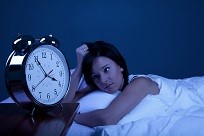93 Insomnia & Older Adults
Based on research by Dana Epstein, et al., 2012, written by Juanita N. Baker, Ph.D..
Do you have trouble falling asleep or staying asleep? Insomnia is prevalent among older adults and associated with depressive symptoms, increased hypnotic medication use, falls, and decreased quality of life. Fortunately psychological research identifies several behavioral methods as effective in reducing insomnia that are recommended as first-line therapy after ruling out medical, drug side-effects, and environmental causes.
Stimulus control therapy involves taking steps to control the sleep environment, using the bed only for sleeping and sex, not for reading, watching TV or other activities. Sleep restriction therapy starts with mild sleep deprivation by only sleeping a minimum amount of time always setting the alarm to arise at the same time; then, going to bed earlier, slowly increasing by 15 minutes daily over 3 weeks, so the body resets its internal sleep clock. Dana Epstein and colleagues in Arizona in a study asked, “Are both of these techniques needed and how do they compare used alone?”
Their results showed that stimulus control therapy, sleep restriction therapy, and using both are equally effective in lengthening sleep time, although in follow-up, combining them better maintained their success.
So establish regular sleep times, use your bed only for sleep, and you will more likely have sweet dreams.
References:
Epstein, D.R., Sidani, S, Bootzin, R.R., & Belyea, M.J. (2012). Dismantling multicomponent behavioral treatment for insomnia in older adults: a randomized controlled trial. Sleep, 35(6), 797-805.





